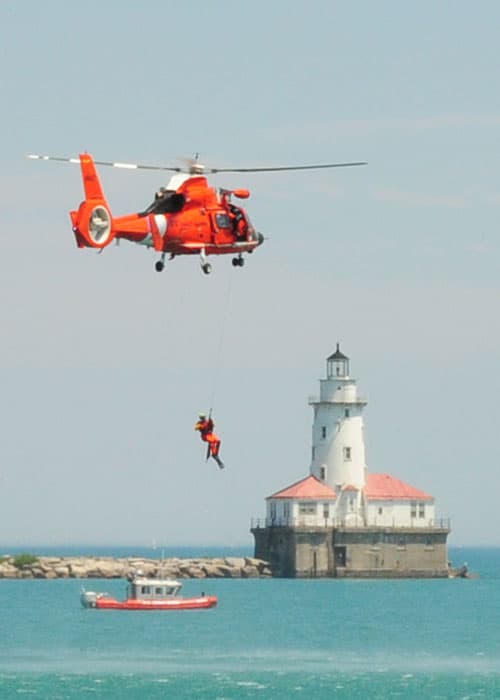 Commissioned in March 1969 by then-Commandant Willard J. Smith, Coast Guard Air Station Chicago, located on the Glenview Naval Air station, was the primary Search and Rescue unit for southern Lake Michigan. It was responsible for the waters from Milwaukee, Wisconsin to Muskegon, Michigan and south to Gary, Indiana. Originally the station was equipped with two HH-52 helicopters. These were later replaced by two HH-65A helicopters. The station had eleven aviators assigned and thirty-four crewmembers, and was on call twenty-four hours a day.
Commissioned in March 1969 by then-Commandant Willard J. Smith, Coast Guard Air Station Chicago, located on the Glenview Naval Air station, was the primary Search and Rescue unit for southern Lake Michigan. It was responsible for the waters from Milwaukee, Wisconsin to Muskegon, Michigan and south to Gary, Indiana. Originally the station was equipped with two HH-52 helicopters. These were later replaced by two HH-65A helicopters. The station had eleven aviators assigned and thirty-four crewmembers, and was on call twenty-four hours a day.
Air Station Chicago’s geographic location brought occasional operational deployments as far south as St. Louis, Missouri, west to Minneapolis, and north to Green Bay, Wisconsin, for such work as flood relief and short range navigation. The preponderance of SAR activity took place between April and November during the boating season. Airevacs were performed throughout the year but were more frequent during the winter because snow storms and Blizzards made ground transportation hazardous and sometimes impossible. Pollution patrols were conducted throughout the year.
On April 1, 1995, Air Station Chicago transitioned to Air Facility Glenview and fell under operational control of Air Station Traverse City. It was manned by Traverse City with one helicopter and two crews from April through mid November. With the impending closure of NAS Glenview, the facility ceased operations on November 15, 1996. On April 1, 1997, Air Facility Muskegon was established and was manned with one HH-65A from Traverse City. In May of 2000, Air Facility Waukegan was established, and Air Station Traverse City slowly transferred operations there. On September 30, 2001, Air Station Traverse City completely transferred Air Facility Muskegon to Air Station Detroit and took control of Air Facility Waukegan. This is still the operational situation today, with both Air Facilities operating from Memorial Day to Labor Day.

